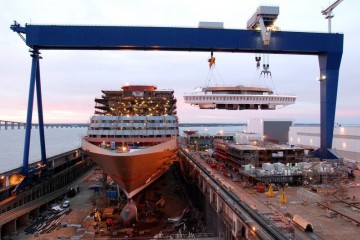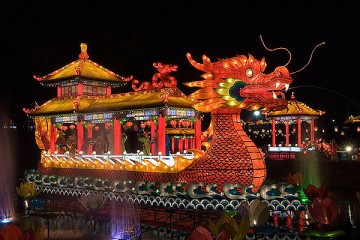OBOR, it could have been the name of the coolest hip hop star in town. New Silk Roads aka OBOR, something like that. The astounding acronym hides a mysterious conceptual subtlety that intellectuals and policy-makers have only started to grapple with. What is OBOR: a strategy, an initiative, a proposal? What does it want: harmony, hegemony, mutual benefits? And what will it mean for the world: opportunity, challenge or something else? In my view, OBOR is unique in two ways: it will bring more choice and more Chinese control of global supply chains. It will have important consequences for the whole world, including for Europe and it requires critical policy choices.
More choice
The global transport model has for a long time been very clear: air is fast but expensive, sea is slow but cheap. So, only high value added and highly time sensitive goods are transported by air, the rest by sea. There were always some options in between, such as rail and combined air-sea transport, but these options were fairly marginal for goods transport between continents.
OBOR will change this model radically. Rail will become a real option for long range freight transport. The most important reason is costs: over 2011-2014 the ratio between Asia-North Europe rail freight rates and ocean freight rates has declined from 13 to 5. As rail volumes grow, this decrease in costs for the rail option will continue. For some origins and destinations, the door-to-door costs for the rail option might already be similar to the ocean option. Moreover, the global sulphur cap for shipping might double maritime transport costs by 2020. So rail transport might become almost as cheap as ocean transport, but much quicker. This provides more choice and flexibility in supply chains, not only for flows between Asia and Europe, but also between Asia and North America; the US East Coast could be served via combined transport (rail between Asia and Europe and ocean between Europe and North America). So it is not so much “One Belt One Road”, but rather multiple Belts and Roads. Rail transport will only be able to absorb a limited part of ocean transport, but for some industrial sectors, this will provide a real alternative. Think of automotive, telecom, components and consumer goods such as cosmetics.
More control
The new maritime Silk Road not only a vision, but also an investment plan. The original map indicated various ports that would be the main nodes for this new Maritime Road. Most of the pieces of the puzzle are already in place. A simple look at the places outside China where Chinese terminal operators have concessions or joint ventures will be sufficient: the new maritime route is already almost reality. Think of Piraeus, Djibouti and Colombo, just to name a few. Some of the ports are no longer favoured or possible, so have been changed for others (Gwadar instead of Kolkata; Tanzania instead of Kenya)
OBOR is a state strategy, but implemented via “private” terminal operators, that is: commercial enterprises owned by the state: most importantly China Cosco Shipping and China Merchants Holdings International. State-owned terminal operators are not exceptional. Some of the largest global terminal operators, such as PSA and DP World, are state-owned enterprises. The fundamental difference is that the Chinese terminal operators have a commercial strategy that seems to be defined – at least partly – in function of the geopolitical strategy of the state.
The missing pieces will be put in place in the next years, via new concessions, acquisitions and other sorts of cooperation. New terminal concessions could be for grasps in Venice (for a new offshore container terminal), Kuala Lumpur (a third container terminal at Port Klang) and Jakarta (phase 2 of New Priok). The financial problems of the shipping industry will help the Chinese, as some of the ailing shipping companies will divest their terminal assets to be able to pay their debts; this could help the Chinese to strengthen their presence in Rotterdam.
The consequences
The impact of OBOR could be spectacular. In Europe alone, it might dramatically reshuffle the ports hierarchy. For decades, we have had an entertaining debate on a possible shift of the traditional dominance of North European ports to South Europe; OBOR might actually make it happen. If the incredible growth rates at Piraeus since the arrival of Cosco are any indication, Europe might be up for a few other surpirses. The position of Rotterdam as node in the land route surely provides it with opportunities, but it might go at the cost of some other ports. Will it in this constellation still make sense to have direct Chinese calls in the UK? Add to this the effects of Brexit, and we could fairly safely predict the end of sea-to-sea transshipment in the UK.
Is Europe prepared?
Europe has its own version of a trans-national transport network: TEN-T. The difference between OBOR and TEN-T is striking: whereas OBOR is focused and externally oriented, TEN-T is characterized by fragmentation and an inward focus. This is most clearly illustrated by how ports are defined in TEN-T maps: as the points where the European network ends, rather than as connections between maritime and land flows. Where OBOR focuses on a dozen of ports, TEN-T considers more than hundred ports as core ports. The European Commission loves to present TEN-T as metro map; but the OBOR-map is more that of a high speed train. How to deal with these fundamentally different approaches – and the lack of focus in the EU ports system as revealed by OBOR?
Europe has a critical choice to make: align to OBOR or propose an alternative. Alignment means: China defines for Europe what are the gateways into Europe. An alternative means: Europe defines what are its main gateways to Europe (not 100, not 50, but let’s say 10) and supports these massively; Venice and Piraeus could be among these gateways, but this is by no means self-evident. The critical question to ask would be: which choice would be most beneficial to European firms and taxpayers? The worst thing to do would just be to muddle through and act as if nothing has happened, because that will lead to a waste of money, without a better supply chain.
So what is needed is a real reflection on the EU ports system. Which ports are needed for which amounts of cargo and which types of ships; which investments are needed where, and equally important: where not to invest? OBOR provides a unique opportunity to reflect on creating more focus, coherence and value in the European ports system.
1 Comments
Comments are closed.




[…] of the EU maritime strategy mentions the cooperation with China as a best practice. But the asymmetry in the relation is strikingly clear. It is China that has defined what are the crucial entry points […]